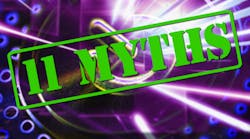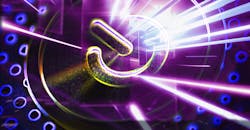In 1904, Nikola Tesla wrote that it was possible “to transmit power, in unlimited amounts, to any terrestrial distance and almost without loss.” He never did it. We began the 20th century expecting global power, and 100 years later, we got charging pads, which offered almost no improvement over cables. Underwhelmed by so-called “wireless power,” our society cooked up self-limiting myths about it.
In the last decade, however, almost all of the old assumptions about wireless power have been challenged. Wireless power is a whole new animal, and it’s time to dispel the myths.
1. “Wireless power” is just those charging pads.
No. When I say “wireless power,” I’m talking ubiquitous, consistent wireless power that’s distributed like Wi-Fi. It requires no plugs, wires, or charging pads. It powers multiple devices in motion, without a line of sight, at distances up to 30 feet. This technology has been around for several years.
2. That type of wireless power must be dangerous.
When wireless power systems are designed properly, they pose no risk to people, pets, and plants. The receiver illuminates the environment with a low-power, omnidirectional signal (Wi-Fi 2.45 GHz) that doesn’t pass through organic matter. It will bounce off walls, floors, and ceilings to reach the transmitter. Then, the transmitter sends power back along the exact paths of incoming signals. This process repeats 100 times per second, protecting organisms from exposure.
3. Won’t we need all new devices for wireless power to be feasible?
No, we can retrofit existing phones, tablets, wearables, etc., with wireless power receivers through their power ports or battery compartments. Some smartphone cases already receive wireless power and transfer it to the device. Long term, it will be more efficient to build wireless power receivers into new electronics during manufacturing.
4. Wireless power can barely charge devices.
Devices such as smoke detectors, remote controls, and thermostats stay confined to one location and consume little power. Devices that travel with us, like our phones and wearables, need to charge quickly because we give them up during the charging process. Wireless power can charge them while in use, so the duration of charging becomes a moot issue.
5. Wired power is 100% efficient.
Now, most people leave their chargers in the wall 24/7. Charging the phone takes about 10 watt-hours, but the charger consumes roughly 12 watt-hours over the course of a day when the phone isn’t connected. In other words, the charger wastes more than two times the power it took to charge the phone. That brings you down to about 14% efficiency for one phone and 7% efficiency if you have two phones or a phone and a tablet.
6. Then from an efficiency standpoint, those charging pads must be the best.
Makers of charging pads will tell you that they’re 70% to 80% efficient. That might be true for the coil-to-coil efficiency, but total efficiency means 70% multiplied by 50% (from the adapter) to give you 35% efficiency while charging for, say, four hours.
However, during those other 20-something hours of the day, that pad is generating a Bluetooth signal so that it can always detect the phone. Over the course of a day, that brings efficiency down by several more percentage points. Thus, pads are less efficient than cables, yet don’t provide any additional value.
7. Wireless power can’t be any better than cables or charging pads.
With a cable, you have one socket charging one device. Wireless power works like Wi-Fi in that you have one source feeding dozens or even hundreds of devices—phones , your kids’ toys, smoke detectors, security sensors, door locks, remote controls, and so on.
The absolute efficiency is somewhere between 1% and 9%, depending on how many devices you’re charging, but the transmitter consumes a fixed amount of power. In other words, wireless power efficiency is in the same ballpark as cables and charging pads. The more devices it charges, the more efficient it becomes.
8. Won’t people steal my wireless power?
Just like a Wi-Fi network, wireless power platforms can encrypt connections between transmitters and receivers and authenticate devices. The transmitter can recognize devices capable of receiving wireless power, but whoever administers the platform decides which devices get power.
9. Wireless power is just a luxury—it has no real benefit for the world.
Wireless power is an environmentalist’s dream because it can eliminate widespread use of disposable batteries. Americans purchase (and dispose of) nearly 3 billion dry-cell batteries every year. They contain toxic materials such as lithium, mercury, acid, lead, nickel, cadmium, and graphite. Dumping batteries in landfills is harmful to the environment, and mining these materials is dangerous for the workers, their families, and their communities. Once batteries are designed to receive and store wireless power, we’ll make and dispose of far fewer batteries.
10. But, wireless power must be super expensive compared to batteries and wires.
A single AA battery delivers 1 watt-hour at the cost of 50 cents. One kilowatt hour of power from a socket costs 10 cents. In other words, the power from a socket is 5,000 times less expensive than the power from a battery. If you replaced batteries with wireless power in a family home, you could easily save $200 to $300 per year, not counting the cost of the time you waste buying and swapping batteries.
Moreover, installing one wire to power a security sensor, thermostat, or door lock can cost over $500 per device. That’s more than the cost of power consumed by a 1-W device in 570 years. Mind you, a 1-W device would burn through the energy of one AA every hour.
11. Ossia's Hatem Zeine has a deep-seated grudge against batteries.
No, but their time has passed! Alessandro Volta invented the first battery in 1800. For perspective, in 1800, Napoleon Bonaparte was emperor of France. Disposable batteries are overdue for retirement. Nicola Tesla realized that, and so should we. It’s time for real wireless power.


